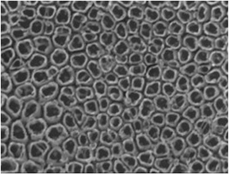Crossref Citations
This article has been cited by the following publications. This list is generated based on data provided by
Crossref.
Kabirian, Fatemeh
and
Mozafari, Masoud
2020.
Nanoengineered Biomaterials for Advanced Drug Delivery.
p.
753.
Wirth, Jonathan
and
Tayebi, Lobat
2020.
Applications of Biomedical Engineering in Dentistry.
p.
149.
Sgarminato, Viola
Tonda‐Turo, Chiara
and
Ciardelli, Gianluca
2020.
Reviewing recently developed technologies to direct cell activity through the control of pore size: From the macro‐ to the nanoscale.
Journal of Biomedical Materials Research Part B: Applied Biomaterials,
Vol. 108,
Issue. 4,
p.
1176.
Hoornaert, Alain
Vidal, Luciano
Besnier, Romain
Morlock, Jean‐Francois
Louarn, Guy
and
Layrolle, Pierre
2020.
Biocompatibility and osseointegration of nanostructured titanium dental implants in minipigs.
Clinical Oral Implants Research,
Vol. 31,
Issue. 6,
p.
526.
Marchezini, Elisa
Oliveira, Fernanda P
Lopes, Rafael
Almeida, Tatiane
Gastelois, Pedro L
and
Martins, Maximiliano D
2020.
Controlling morphological parameters of a nanotubular TiO2 coating layer prepared by anodic oxidation.
Materials Research Express,
Vol. 7,
Issue. 2,
p.
025017.
Scandurra, Roberto
Scotto d’Abusco, Anna
and
Longo, Giovanni
2020.
A Review of the Effect of a Nanostructured Thin Film Formed by Titanium Carbide and Titanium Oxides Clustered around Carbon in Graphitic Form on Osseointegration.
Nanomaterials,
Vol. 10,
Issue. 6,
p.
1233.
Liao, Chengzhu
Li, Yuchao
and
Tjong, Sie Chin
2020.
Visible-Light Active Titanium Dioxide Nanomaterials with Bactericidal Properties.
Nanomaterials,
Vol. 10,
Issue. 1,
p.
124.
Carobolante, João Pedro Aquiles
da Silva, Kerolene Barboza
Chaves, Javier Andres Munoz
Dias Netipanyj, Marcela Ferreira
Popat, Ketul Chandrakant
and
Alves Claro, Ana Paula Rosifini
2020.
Nanoporous layer formation on the Ti10Mo8Nb alloy surface using anodic oxidation.
Surface and Coatings Technology,
Vol. 386,
Issue. ,
p.
125467.
Alipal, J.
Lee, T.C.
Koshy, P.
Abdullah, H.Z.
and
Idris, M.I.
2021.
Evolution of anodised titanium for implant applications.
Heliyon,
Vol. 7,
Issue. 7,
p.
e07408.
Mahadule, Diksha
Khatirkar, Rajesh Kisni
Gupta, Aman
and
Kumar, Ranjeet
2021.
Effect of heating temperature and cooling rate on the microstructure and mechanical properties of a Mo-rich two phase α + β titanium alloy.
Journal of Materials Research,
Vol. 36,
Issue. 3,
p.
751.
Zhang, Chaoyang
Lu, Zhenlin
Li, Feizhou
Jia, Lei
Yang, Zhiquan
Chen, Guoqing
Yu, Qiangliang
Dong, Rui
and
Cai, Meirong
2021.
Corrosion and lubrication properties of a halogen-free Gemini room-temperature ionic liquid for titanium alloys.
Tribology International,
Vol. 156,
Issue. ,
p.
106850.
Alipal, J.
Mohd Pu'ad, N.A.S.
Nayan, N.H.M.
Sahari, N.
Abdullah, H.Z.
Idris, M.I.
and
Lee, T.C.
2021.
An updated review on surface functionalisation of titanium and its alloys for implants applications.
Materials Today: Proceedings,
Vol. 42,
Issue. ,
p.
270.
Pan, Lei
Xue, Pengbo
Wang, Menglin
Wang, Fei
Guo, Huaxin
Yuan, Xiaosa
Zhong, Lang
and
Yu, Jia
2021.
Novel superhydrophobic carbon fiber/epoxy composites with anti-icing properties.
Journal of Materials Research,
Vol. 36,
Issue. 8,
p.
1695.
Wei, Yujia
Chen, Maohua
Li, Menghuan
Wang, Dong
Cai, Kaiyong
Luo, Zhong
and
Hu, Yan
2022.
Aptamer/Hydroxyapatite-Functionalized Titanium Substrate Promotes Implant Osseointegration via Recruiting Mesenchymal Stem Cells.
ACS Applied Materials & Interfaces,
Vol. 14,
Issue. 38,
p.
42915.
Barberi, Jacopo
Ferraris, Sara
Giovannozzi, Andrea Mario
Mandrile, Luisa
Piatti, Erik
Rossi, Andrea Mario
and
Spriano, Silvia
2022.
Advanced characterization of albumin adsorption on a chemically treated surface for osseointegration: An innovative experimental approach.
Materials & Design,
Vol. 218,
Issue. ,
p.
110712.
Remizova, Anna Alexandrovna
Bitarov, Pavel Alanovich
Epkhiev, Alexander Alibekovich
and
Remizov, Nikolay Olegovich
2022.
Reparative-regenerative features of bone tissue in experimental animals treated with titanium implants.
Journal Of Advanced Pharmacy Education And Research,
Vol. 12,
Issue. 2,
p.
110.
Hasan, Jafar
Bright, Richard
Hayles, Andrew
Palms, Dennis
Zilm, Peter
Barker, Dan
and
Vasilev, Krasimir
2022.
Preventing Peri-implantitis: The Quest for a Next Generation of Titanium Dental Implants.
ACS Biomaterials Science & Engineering,
Vol. 8,
Issue. 11,
p.
4697.
2022.
Fabrication of Oxide Coatings on Titanium Alloy Ti6Al4V by Electrochemical Oxidation in Succinic Acid Solutions.
Nanosistemi, Nanomateriali, Nanotehnologii,
Vol. 20,
Issue. 1,
Gupta, Aman
Khatirkar, Rajesh
and
Singh, Jaiveer
2022.
A review of microstructure and texture evolution during plastic deformation and heat treatment of β-Ti alloys.
Journal of Alloys and Compounds,
Vol. 899,
Issue. ,
p.
163242.
Marchezini, Elisa
de Almeida, Tatiane Cristine Silva
Oliveira, Fernanda de Paula
Albergaria, Juliano Douglas Silva
Ghosh, Santunu
Tavares, Mariana Andrade Boense
Leite, Ramon Resende
Silva, Gerluza Aparecida Borges
and
Martins, Maximiliano D.
2022.
Comparative Study of Nanostructured TiO2 and SLA Surface Modifications for Titanium Implants: Surface Morphology and in vitro Evaluation.
Materials Research,
Vol. 25,
Issue. ,
